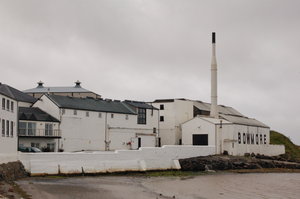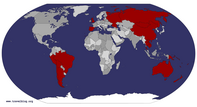Advertisement
Published: September 16th 2010

 Bowmore distillery
Bowmore distillery
This is perhaps my favourite picture of the weekendFor Steve’s stag weekend, we went to the Hebridean island of Islay, off the west coast of Scotland. I met up with Allan in Glasgow and after a lager on Thursday evening we flew early Friday morning, on a Saab turbojet.
On this dull morning, the water droplets on the plane windows were dispersed as soon as the propellers were switched on, and to reinforce the small scale of the operation, the chief stewardess announced “I'm Helen and I am your cabin crew today!” To be fair, there were only 39 seats in total, and less than a third were occupied.
A short hop over such dreamy-sounding waterways as the Firth of Clyde, the Sound of Bute and the Sound of Jura took us to Islay, just a handbrake turn before the Atlantic Ocean, a place 25 miles long and 20 miles wide, with 3,500 resident souls.
As we would come to find out, it was an island of green landscapes and isolated sandy beaches, lapped by chilly waters, behind which lay rugged hills and parcels of farmland. Very nearby was the island of Jura, with just one distillery but 3 large mounds known as the Paps of

 Map of Islay
Map of Islay
The "Queen of the Hebrides" is 0.029 times the size of Wales (www.islayblog.com)Jura, across to which we would occasionally gaze to see if they were visible.
There are 8 distilleries on Islay, and Steve/Kev had come up with a great plan to ensure that we visited them all. Although all the distilleries produce Single Malt whisky, there was a lot of variation between them. The newest,
1. Kilchoman, was the first that we visited, and the first new distillery to be built on the island in over 120 years. But what they all had in common was really good knowledge of their products, and a willingness to give us tastings (even though we only managed a tour of one). Those whose distilleries were on the waterside all had their names writ large (big black letters on a white background) on the side of the buildings for identification, in a nod to the past when supply ships would moor beside them.
I won’t write any of the distillation process here (it seemed very complex), but it was interesting to see the bright copper stills and huge wooden mash tuns that make the whisky destined to be sent all over the world as ‘best in class’.
So on Friday in the
drizzle that followed us from Glasgow, we visited the aforementioned Kilchoman, whose whisky had a very peaty flavour (which does not come from the water, but from the drying process of the damp malt over a peat-heated fire, where the smoke gets into the barley. The difference in the smokiness of a whisky depends on the time the barley is exposed to the peat smoke, and Islay peat is made up of salt-sprayed heather, ferns, gorse, seaweed and moorland grass - very medicinal!).
This was followed by a visit to the well-known
2. Caol Ila distillery, on the east coast, which on a more clear day would have been the ideal place to catch views over to Jura and the previously-referred to Paps. Standing at the bottom of a steep hill with its own pier, it shares a rocky shoreline with seals and otters, and overlooks the deep waters of the Sound of Islay, across to those mountains of Jura.
The last distillery of the day was
3. Bunnahabhain, the only distillery where we did a tour, which we double-checked was still going ahead (see footnote). "Definitely subtler and more easily accessible are the more northerly products of
Bowmore, Bruichladdich, and best of all Bunnahabhain...all caramel and fruit-cake, and for some a touch of the sea-spray that wafts over the distillery that is probably the most beautifully situated of all on Islay" (http://www.information-britain.co.uk)
We had a very detailed description of the process from the guy at Bunnahabhain, and visited the cask storehouse where hundreds of barrels were simply on their sides, playing star roles in the maturation process, before trying the best-selling 12-year old in the small souvenir shop. I bought a couple of glasses, as prior to my trip Bunnahabhain was my favourite Scotch.
By the time we came out, the sun was shining for the first time, and as such we kicked around on the beach before having a few pints and yet more whisky in the only 2 bars in the village where we were staying, Port Charlotte, one of which had a whisky menu with 123 varieties. We did try the beer brewed by Islay’s only brewery, but despite trying several of the varieties we concluded that it was not up to scratch for general sale to the public, more like home-brew standard. If we come back, we’ll try it again and
hope they’ve upped their game.
We knew Saturday would be the challenge; as we woke up and looked out of the window, a light rain flecked the window panes; after rounds of bacon sandwiches we set off on bikes in the drizzle, on the start of a 24-mile ride around the 5 other distilleries on the island. Our early reward was the first whisky of the day, at 10:15 after 2 just miles and dripping wet, in the large reception area of the phoenix-like
4. Bruichladdich distillery.
We all appreciated the whisky here, and the fact that it was only 1 of 2 independent distillers on the island. Without a huge marketing budget it distinguishes itself by using its turquoise colour scheme across its range - and also across the distillery.
It was 8 miles in the saddle and through the rain to reach
5. Bowmore, along a small curvy road but still important enough to be called the A847, a road past a small sandy beach and through grassy wetlands bordered by purple Scottish thistles. The village of Bowmore is the capital of Islay, and the distillery (now owned by Japanese Suntory) had made the most
of its waterfront location by having a balcony. Not only that, the weather had cleared up, so we could do our tasting outside, overlooking Loch Indaal. Inside, it was one of the most impressively modern rooms, with floor to ceiling glass and views across the loch.
This was followed by the biggest cycle stretch of the day, 12 miles southeast to the south coast of the island. It was uphill out of Bowmore, past the 1767
Round Church, along a straight road with quite unchanging scenery that passed a few houses (almost all amazingly white-washed) and an ancient peat bog (where people are still cutting blocks for fuel).
We took a break for sandwiches at the picnic tables round the back of the airport, which was locked as there were no flights anytime soon; and which also had a cattle grid at the entrance…!
Carrying on through the picturesque bay of Port Ellen, there were a few hills (better to zoom down them) and indolent cattle grazed comfortably in the rolling pastures, the green scenery looking so fresh in the sun which by this point was well-established, providing a pleasant front-drop to the larger hills (
beinns) in the

 So near So Spar
So near So Spar
Allan & I called in to Spar in between sampling a cheeky beer and getting to the next distillery, where we found rifles for sale.middle of the island, whose peaks were up to 500m.
An hour after we last stopped, we wheeled into the hallowed tasting bar of the
6. Laphroaig distillery, a byword all over the world for peaty whisky - in fact it has its own peat beds on Loch Indaal. The knowledgeable and friendly girls there offered us a choice of the standard 18 year old, or the Cask Strength, or the Quarter Cask, and we tried the lot between us. There was also a great history of the company in the small distillery museum.
Just up the road was
7. Lagavulin, one of the most cosy and friendly distilleries we went to, taken as we were into a parlour-like room in the large converted building, and also had the chance to try several varieties, talked through by a passionate and enthusiastic native Islay-man.
To finish the day off, we headed back up a hill and then freewheeled down another, straight into
8. Ardbeg. While the experiences we had had in all the other distilleries without exception were open and welcoming, Ardbeg somewhat let the side down, but on the positive side we did enjoy what we tried,
and their location - literally on the seafront at the end of the road - was a pleasure to walk around.
In a stroke of genius by Kevin and Steve, a minibus took us, with various aches and tender bits, all the way back to Port Charlotte where we finished off the day back on the beach, having a paddle in the loch (Kevin and Ritchie deciding to opt for full-body immersion), with a very satisfied feeling of having covered the island, and (amazingly) even a little bit sunburnt, judging by the pink faces in the evening.
We only had to hobble 100 metres to the pub for dinner, but not before presenting Steve with an Islay mug and a miniature or half-bottle from each of the distilleries we had visited to enjoy at a later date.
So, what happened to Steve on his stag? Well, you know the rules about divulging what happens On Tour, but lets just say that Islay will remain a place of memories that no amount of single malt will be able to erase.
*****
+ The recounting of the conversation is recorded here. Even though it does not mean
much when read in black and white, the recollection of it was a source of entertainment.
- Is the 3 o’clock tour of the distillery open?
- AYE, IT IS.
- Can I check that you have our group on it?
- THERE IS A PARTY OF FOUR UNDER THE NAME OF MC, AND A GROUP OF 8, IN RED.
- That’s us, do you need the name of the group?
- THERE’S NO NEED. JUST TURN UP.
Advertisement
Tot: 0.12s; Tpl: 0.012s; cc: 16; qc: 24; dbt: 0.0572s; 1; m:domysql w:travelblog (10.17.0.13); sld: 1;
; mem: 1.1mb





















